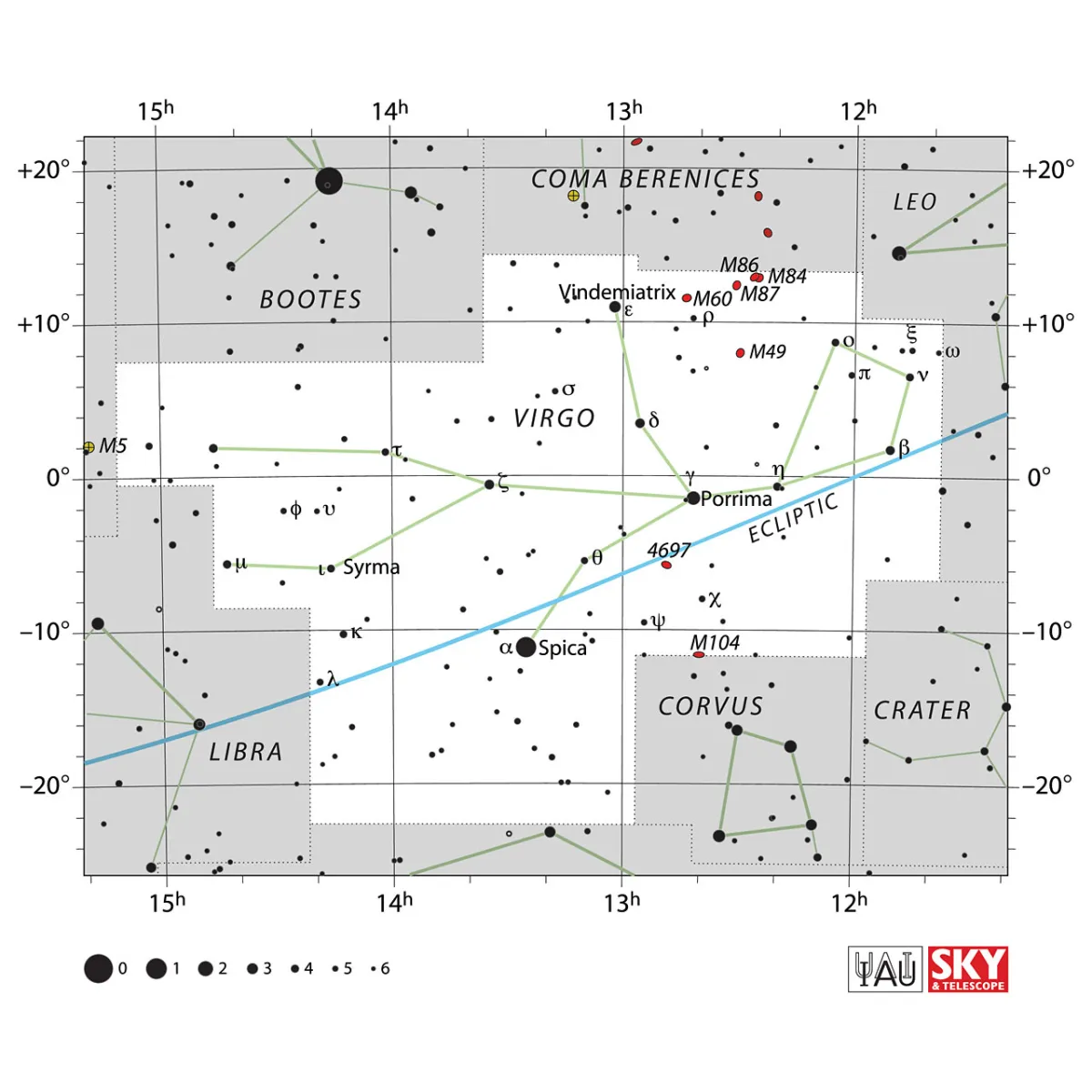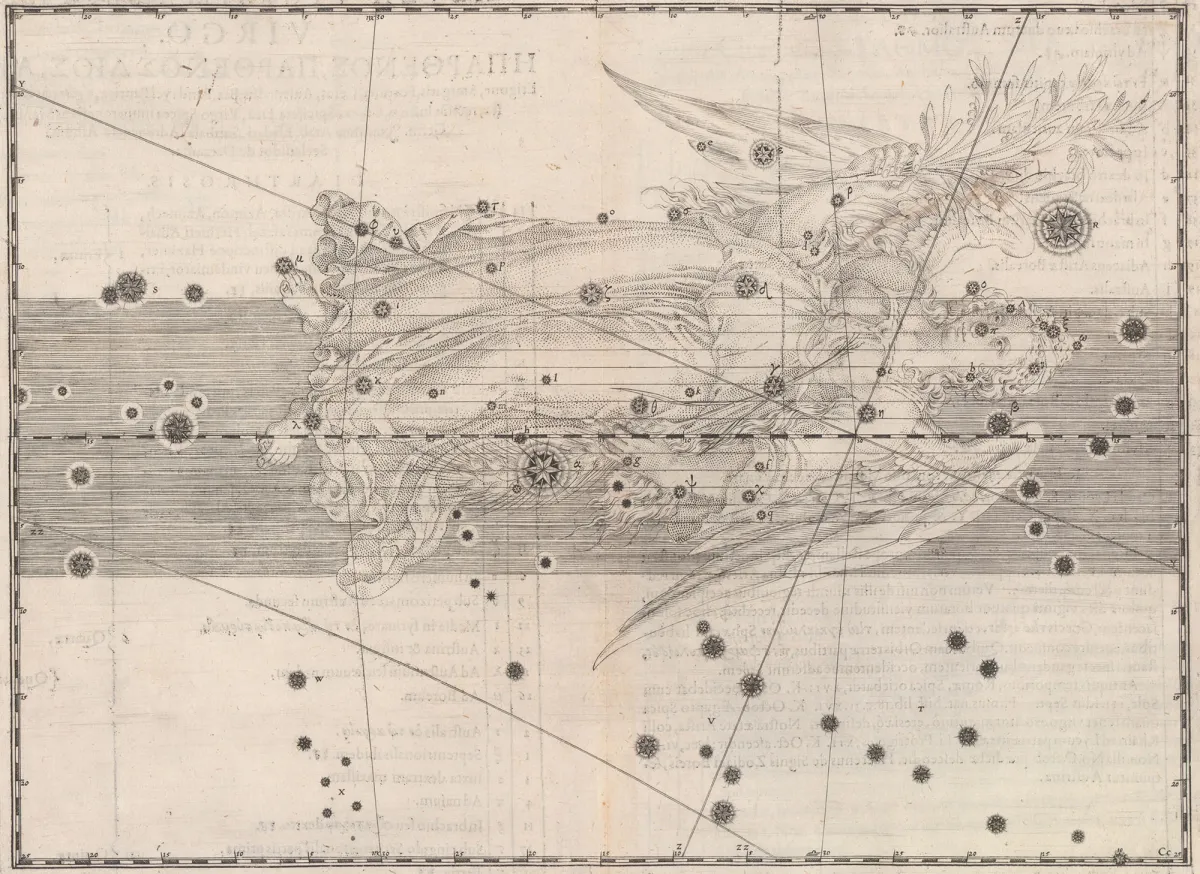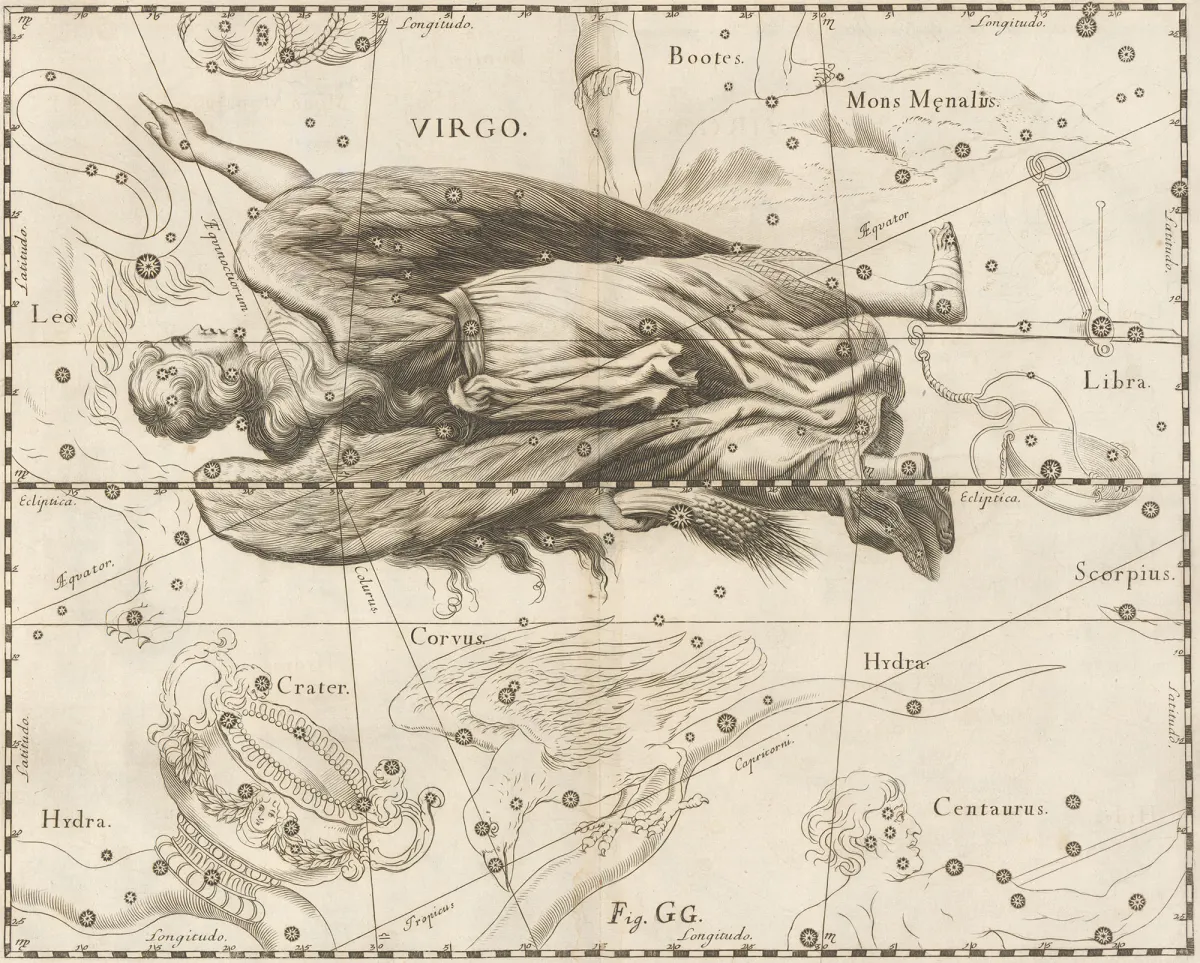Constellation Virgo (Maiden)

Properties
The constellation Virgo is not particularly noticeable, but it is easy to find. You just follow the curve of the drawbar of the Big Dipper over Arcturus in the constellation Bootes to the Spica, the brightest star in the constellation Virgo. The alignment itself does not have a particularly distinctive shape, but with a lot of imagination you can recognize a woman in stick figures on some star maps, who lies there with spread legs and open arms, even if this is not exactly virgin and virtuous and is not the case in pictorial representations. The area of the constellation is 1294 square degrees, making it the second largest in the sky. The centre culminates around midnight on 12 April. [9, 15]
| α Vir | Spica, Azimech, Spica Virginis, Alaraph |
| β Vir | Zavijah, Zavijava, Zavyava, Zawijah, Zarijan, Minelauva, Alaraph |
| γ Vir | Porrima, Arich |
| δ Vir | Auva, Minelauva |
| ε Vir | Vindemiatrix, Vindemiator, Vendemiatrix, Almuredin, Provindemiator, Protrigetrix, Protrygetor, Alaraph |
| ζ Vir | Heze |
| η Vir | Zaniah |
| ι Vir | Syrma |
| μ Vir | Rijl Al Awwa |
| IAU Name | Virgo |
| IAU Genitive | Virginis |
| IAU Abbr. | Vir |
| English Name | Maiden |
| Culmination at local midnight | 12 April |
| Season (Latitude +0.0°) | December … September |
| Right Ascension (J2000.0) | 11h 37m 22s … 15h 11m 25s |
| Declination (J2000.0) | -22° 40' 38" … +14° 21' 38" |
| Area | 1294 deg2 |
| Neighbours (N↻) | Com, Leo, Crt, Crv, Hya, Lib, Ser, Boo |
Deep-Sky Object Descriptions
Messier 87
Messier 104
NGC 4216
NGC 4435/8
NGC 4535
NGC 4567/8
Catalogues
Mythology and History
The Greeks saw Persephone in this constellation, the beautiful daughter of Demeter, the Greek goddess of agriculture, fertility and marriage. One day, while Persephone was walking in the field, she was kidnapped by Hades. The earth opened up and he disappeared with her on his black chariot into the underworld, where she was to become his wife. Demeter was so affected by the loss of her daughter that she forgot to carry out her duties. Harvests failed and people began to starve to death. Zeus, the king of the gods, finally worked on a compromise. Persephone was to spend half of the year with her mother and the other half in the underworld with her husband. So he moved her to a place under the stars. When Persephone is in the underworld, the world remains in the cold of winter, when she returns to her mother Demeter, spring begins again. [79]

According to another legend, the virgin Astraea, the goddess of justice, was the daughter of Zeus and Themis, who lived the earth in the Iron Age, when people no longer respected justice, left in disgust, flew up to heaven and became the constellation Dike. The peace-loving farmers - it is said - missed her very much and looked up to this constellation for comfort, from which she shone upon the goddess of justice.
The constellation of Virgo is also associated with Ikarios (Bootes). He learned the art of pressing from Dionysus and was killed by drunken shepherds who believed they were enchanted. After they had slept off their intoxication, they buried Ikarios under a fir tree and carefully covered all traces so that their deed would not be known. Ikarios' daughter Erigone did not know where her father was until her dog Maria (Ursa Minor) dragged her by one corner of her robe to the place where her father was buried by the murderers had been. Erigone was desperate and hanged herself from the Christmas tree that stood by her father's grave. The dog, grieved over the deaths of the two, threw himself into a nearby well.
When Dionysus heard this terrible news, he was so furious that he cast a curse on the maidens in Athens, which caused them to hang themselves from trees. The citizens of Athens were so terrified that they consulted an oracle. The oracle said that the death of the virgins could only be stopped if Ikarios' murderers were found and punished. It was done quickly. Later the Athenians celebrated the death of Icarius and Erigone every year at the grape harvest festival. Drink offerings are made to Ikarios and Erigone and girls swing on ropes in the tree branches, standing on small boards.
Dionysus gave Ikarios, his daughter and her dog a place under the stars. Ikarios became Bootes, Erigone became Virgo, and the dog became Canis Minor .

The ancient Egyptians identified the constellation Virgo with the goddess Isis, the heavenly wife and mother, and the brightest star was worshiped as the lute bearer. It is believed that at least one of the temples of Akhenaton's royal city, now known as Tell el Amarna, was aligned with the location of the star Spica. If so, it could be that this most headstrong and enigmatic of the pharaohs, often considered the “first monotheist in history”, paid homage to his own “Heavenly Mother”, the exotic and lovely Nefertiti.
The constellation Virgo has also been associated with a «mother goddess» in other countries: in Assyria she was the wife of Bel, in Babylonia she was Ishtar, queen of the stars and in India she was associated with Kanya, the girl and mother of Krishna.
In addition to Ishtar, the ancient Babylonians saw an ear of corn (Spica) in this star configuration, which spends part of the year underground and sprouts out of the earth in spring to stand in the sky.
The virgin is often depicted with a palm branch in her right hand and the spica, the ear of wheat, in her left. In the constellation of Virgo you can see Persephone, who the Romans called Proserpina, i.e. the daughter of the fertility goddess Demeter (Ceres). Because the virgin carries the wheat ear, she has also been called Spicifera Vorgo Cereris and Virgo Spicea Munera Gestans, but also Aristae Puella. The virgin was also depicted as the goddess of justice with a scales (constellation Libra) and named Iusta and Iustitia and even explicitly Astraea (goddess of justice ) called. The terms Pax (peace), Concordia (goddess of harmony), Fortuna (goddess of fate and luck) and others can also be found. In the Christianized starry sky, the Virgin has transformed into the Virgin Mary. [20]